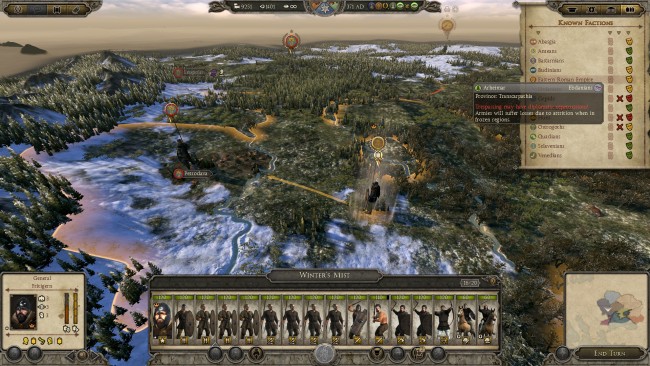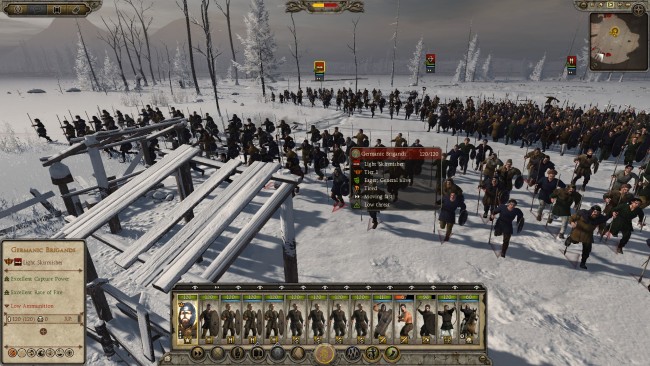
Screw The Huns, man. Here I am, the innocent and peaceful leader of The Saxons, quietly chipping a bloody path to the west, when out of freakin’ nowhere hordes of Huns start razing everything around me! What the hell, Uldin!? I’m no master of diplomatic relations, but that’s not how I’d introduce myself to new neighbours. I needed to respond like the vengeful, merciless hand of God, so I stopped playing The Saxons and played The Huns instead (if you can’t beat ’em, join them, right?). After my first attack, my opinion had drastically shifted, and not just because I wasn’t curb stomped by Attila’s army of douche bags; the game had turned upside down.

From the ground up, the Huns played completely differently to The Saxons, and they both played differently to The Romans. I was spending more time in the revamped battle system and less time bogged down by parts of the game I saw more as formalities. Going back to other factions certainly wasn’t a chore, but the best parts of Total War: Attila are highlighted by The Huns. Better AI, splendid visuals, and more variation between factions’ play styles, all accompanied by the familiar scale we’ve come to expect from the Total War series. It still has some niggly issues, but as far as Total War games go, it’s a bloody good one.
Total War: Attila is set in the good ol’ days of 395-450 AD, back when The Roman Empire was collapsing and The Dark Ages were coming into fashion. As with other Total War games, there’s no storyline per se, just a segment of history for you to mess around with. If you want to make sure The Romans stay on top or ensure Ostrogoths forge the empire they deserved, you can try and change history to your liking. It’s always fun to mess around and see what historical manipulation you can pull off, but it’s in the details where the past comes through.

One of the things that Total War games have done well has been implanting historical details, and Attila carries on the standard fare. There are historical battles that offer glimpses of the past, and each faction’s look and gameplay mimics that of its legacy. The lack of a more linear campaign that chronicles significant events in a faction’s historical journey might seem like an oversight to some, but this isn’t a game of following in history’s footsteps. While the details are there, it’s up to you to forge the course of history, and Attila lets you do it better than any other Total War game from recent memory.
Just like it’s predecessors, Attila is a huge game**. I haven’t had time to get through more than half of a grand campaign while reviewing it (let alone see every faction through), and there are a heap of mechanics at play. There’s a tech tree, diplomacy, city management, political intrigue, just about everything you can think of that would be relevant to a grand strategy game. It’s a lot to take in for a newcomer, but with your helpful advisor and tool tips at your side, everything eventually falls into place. Eventually.

**Yes, the game is big, but DLC for Attila was made available from day one. I didn’t factor this into my review because I didn’t get copies of them, nor do I see how it would significantly impact the core gameplay. The fact that these DLC packages weren’t already in the release version is both annoying and understandable. I’m annoyed that they aren’t just in the release version, but there is honestly enough variety already to sustain most people. The pricing is BS though, and I’d think through supporting such steep prices for little additional content.
There’s a lot of stuff to take in if you’re a new chieftain, some areas more so than others. The tech tree from Rome 2 that looked like Plato designed it in a bad mood has been shrunk down to just military and civil advances, which makes seeing ahead a lot easier. Unfortunately, not everything is so easy to take in at a glance, with the family tree feeling like sloshing through tar. What anything does in the family tree is glossed over by your advisor, and that doesn’t help the feeling that maybe the game is just a bit too complicated for its own good. Once you get past the extreme amounts of information (that you might like), the different parts of the game fall into place, and there’s more variety to it than previous Total War games.

While the usual practice of Total War games has been to put the player in control of a fledgling empire and let them go from there, Attila provides a few more variations at the start of the game. If you play as The Romans, you start off with an empire already established, so keeping it from falling apart is the challenge. The Huns don’t even have the ability to settle, so they require constant movement and looting to survive. Then there are The Migrants (Ostrogoths, Alans, etc.), The Sassanids, and Germanic Tribes (Franks, Saxons) who all start and play differently to one another. It’s nice to see more variety than in previous titles, but this appreciation can be dulled by how the game plays at times.
Even though Attila plays well most of the time, there are glaring moments where you’ll be reminded that the game is too big to get all the tiny issues out. In both the campaign map and the battles, I got consistent frame rates and had no trouble giving orders to my men. However, if I hovered over a particular unit or the battle was starting to heat up, the frame rate would bomb, and I’d be left with a sluggish client to issue my orders through. The campaign is turn based, and you can pause battles whenever you want, so it’s not a deal breaker. That said, it’s not ideal for these inconsistencies to arise as often as they do, especially when coupled with the tiresome UI.

The UI is tasked with providing the player with so many tools for ruling that it’s easy to become lost, and if you’re new to Total War, you’ll struggle. I’ll give props to the designers for cramming so much information into a screen, but it’s very easy to become distracted by the clutter of information. There are tooltips to help navigate through it, but this might not help in distilling the information down. On top of this, going from one screen to another for the information you want (which I did a lot) can feel like a laborious back-and-forth. I also don’t understand why the encyclopaedia wasn’t built directly into the game instead of opening a browser to the wiki online. Waiting for it to load takes a dark age, and if I couldn’t connect to it because of my Australian internet, I couldn’t access the information I wanted. I wouldn’t go so far as to say that it’s the worst possible UI the devs could have made, but there’s clear room for improvement. Past these niggly issues, Attila’s a solid game.
Despite the occasional hiccup in frame rate, I only encountered one bug in my entire playthrough. This is astonishing to me because every other Total War game has been a clunky mess on release, but not Attila! Even the AI was solid as hell, making decisions that could be classified ‘sensible’ by human standards. There were still moments where the AI made a predictably AI move, but it never ran men in circles like dogs obeying their drunk master. The only bug I had was when I played the prelude campaign (aka, the tutorial) and slightly deviated from what I was ‘meant’ to do. Everything stopped working as intended after that, but everything else I’ve played has run exceptionally well, so I’d say it’s forgivable. It might still have some kinks, but Attila plays pretty damn well, and it looks damn good too.

The level of detail in Attila is goddamn phenomenal. As your men bombard the enemy with a shower of arrows, you might see a family of deer making a run for it towards the horizon. You’ll hear your general bolster your men with a glorious speech as you zoom into your lines of troops, each one rendered individually with ridiculous amounts of detail. Considering the scope of what you’re looking at, the game brings crazy amounts of graphical nuance to the fore… At a cost.

If you don’t have a beast, you’ll be stuck with this.
The game looks good, but your machine will have to run hard to get it looking it’s best. The frame rate issues from earlier certainly factor into how smooth the game looks, but the graphical fidelity of the game has been designed with future technology in mind. To get the best looking game you can, you’ll need to… Wait. Even if you have a Titan, you’ll need to wait until future technologies are the norm before you’ll get a crisp 60 with max settings. It’s a strange move because the game is being released now, so optimising it for future tech means that current customers won’t be able to enjoy all that the game has to offer, graphically speaking. It can still look damn pretty though; you’ll just need a beast to get it working.
 Massive scale
Massive scale
 Better AI
Better AI
 More variety between factions
More variety between factions
 Exceptional detail
Exceptional detail
 UI can be a hassle
UI can be a hassle
 Occasional chugging
Occasional chugging
 Tutorial still sucks (and breaks)
Tutorial still sucks (and breaks)
There are still kinks that could be sorted out, but Attila is one of the best Total War games I’ve played. There’s more variety, better AI, and design improvements over older Total War games that I gladly welcome. It’s still not the perfect grand strategy game that hardcore fans will hope for, but it’s a great addition to a niche genre. Except for The Huns. Screw those guys, plundering sons of bitches.
DISCLAIMER: This game was provided to the writer by the publisher for the purpose of review, and reviewed across the course of approximately 10 hours of gameplay. Additionally, the multi-player aspect of the game was not investigated.











